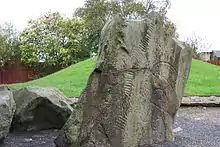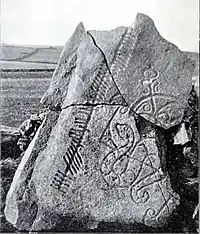Brandsbutt Stone
The Brandsbutt Stone is a class I Pictish symbol stone in Inverurie, Aberdeenshire, Scotland.
| The Brandsbutt Stone | |
|---|---|
 The Brandsbutt Stone, showing detail of ogham script | |
| Material | Whinstone |
| Height | 1.07 metres (3.5 ft) |
| Writing | Ogham script: irataddoarens |
| Symbols |
|
| Present location | Inverurie, Aberdeenshire, Scotland |
| Coordinates | 57.2916°N 2.4000°W |
| Classification | Class I incised stone |
| Culture | Pictish |
Description
A large block of whinstone, 1.07 metres (3.5 ft) high, 1.27 metres (4.2 ft) wide and 0.91 metres (3.0 ft) deep, the stone had been broken up and used in building a dry stone wall before 1866.[1] The stone, now reassembled, bears two incised Pictish symbols, a crescent and v-rod and a serpent and z-rod, and an inscription in Ogham, IRATADDOARENS.[2] The carvings of the Brandsbutt Stone are dated to around AD 600.[3] It is a scheduled monument.[4]
Inscription

The inscription borne by the Brandsbutt Stone, IRATADDOARENS, has been described by Katherine Forsyth as appearing to be "utterly baffling".[5] However, a handful of interpretations have been offered.[5][2] Suggestions include the possibility that it may contain a corrupted version of the personal name Ethernan.[6][2] If this is the case, it is likely to refer to the 7th century saint Ethernan about whom little is known but who was apparently venerated by the Picts. He is referred to in an entry from the Annals of Ulster from 669 AD as having been killed by the Picts along with Corindu. It is thought that these names may be P-Celtic and therefore Pictish in origin.[7]
Other examples of the name Ethernan being preserved on Pictish stones include, in Ogham, The Newton Stone (IDDARRNNN), Rodney's Stone (EDDARRNON) and The Scoonie Stone (EDDARRNONN), and, in Latin script, The Fordoun Stone (PIDARNOIN).
The ira- may be a Pictish verb cognate with Breton irha meaning "he lies".[5]
References
- Fraser, Iain (2008), The Pictish Symbol Stones of Scotland, Edinburgh: Royal Commission on the Ancient and Historic Monuments of Scotland, pp. 62–63
- "Brandsbutt Symbol Stone - Historic Environment Scotland". Retrieved 5 February 2018.
- Dating of the Brandsbutt Stone
- Historic Environment Scotland. "Brandsbutt Stone, symbol stone (SM90039)". Retrieved 13 March 2019.
- Forsyth, Katherine (1997). Language in Pictland – the case against 'non-Indo-European Pictish' (PDF). De Keltiche Draak. p. 36. ISBN 9789080278554. Retrieved 20 August 2018.
- Mack, Alastair L. (1997), Field Guide to the Pictish Symbol Stones, Balgavies: The Pinkfoot Press
- Clancy, Thomas Owen (2008). "Deer and the early church in North-Eastern Scotland". In Forsyth, Katherine (ed.). Studies on the Book of Deer. pp. 375–77.
External links
- Entry in Canmore database